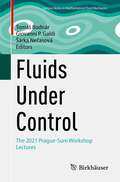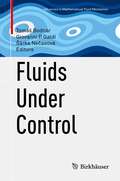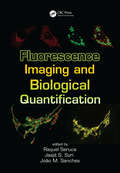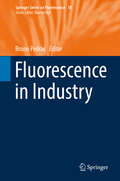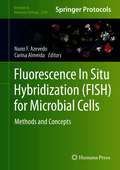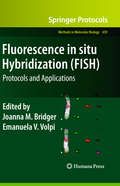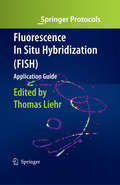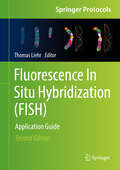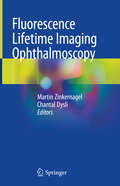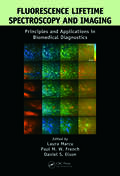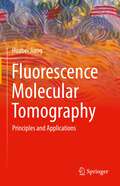- Table View
- List View
Fluids Under Control: The 2021 Prague-Sum Workshop Lectures (Advances in Mathematical Fluid Mechanics)
by Tomáš Bodnár Giovanni P. Galdi Šárka NečasováThis volume presents state-of-the-art developments in theoretical and applied fluid mechanics. Chapters are based on lectures given at a workshop in the summer school Fluids under Control, held in Prague on August 25, 2021. Readers will find a thorough analysis of current research topics, presented by leading experts in their respective fields. Specific topics covered include: Magnetohydrodynamic systemsThe steady Navier-Stokes-Fourier systemBoussinesq equationsFluid-structure-acoustic interactions Fluids under Control will be a valuable resource for students interested in mathematical fluid mechanics.
Fluids Under Control (Advances in Mathematical Fluid Mechanics)
by Tomáš Bodnár Giovanni P. Galdi Šárka NečasováThis volume explores state-of-the-art developments in theoretical and applied fluid mechanics with a focus on stabilization and control. Chapters are based on lectures given at the summer school “Fluids under Control”, held in Prague from August 23-27, 2021. With its accessible and flexible presentation, readers will be motivated to deepen their understanding of how mathematics and physics are connected. Specific topics covered include:Stabilization of the 3D Navier-Stokes systemFlutter stabilization of flow-state systemsTurbulence controlDesign through analysis Fluids Under Control will appeal to graduate students and researchers in both mathematics and physics. Because of the applications presented, it will also be of interest to engineers working on environmental and industrial issues.
Fluids Under Pressure (Advances in Mathematical Fluid Mechanics)
by Tomáš Bodnár Giovanni P. Galdi Šárka NečasováThis contributed volume is based on talks given at the August 2016 summer school “Fluids Under Pressure,” held in Prague as part of the “Prague-Sum” series. Written by experts in their respective fields, chapters explore the complex role that pressure plays in physics, mathematical modeling, and fluid flow analysis. Specific topics covered include:Oceanic and atmospheric dynamicsIncompressible flowsViscous compressible flowsWell-posedness of the Navier-Stokes equationsWeak solutions to the Navier-Stokes equationsFluids Under Pressure will be a valuable resource for graduate students and researchers studying fluid flow dynamics.
Fluidverfahrenstechnik: Grundlagen, Methodik, Technik, Praxis
by Ralf GoedeckeVon Praktikern für Praktiker geschrieben, erläutert das vorliegende Werk die prozesstechnische Behandlung von Flüssigkeits- und Gasgemischen zur Reinigung, Auftrennung und Aufkonzentrierung der einzelnen Komponenten durch den Einsatz selektiver Trenntechniken: - Absorption - Rektifikation - Verdampfung - Kondensation - Extraktion - Adsorption - Chromatographie - Membrantechnik - Schmelzkristallisation - Trenntechnik mit überkritischen Fluiden Alle zum Verständnis der Unit-Operations notwendigen Grundlagen aus den Bereichen Thermodynamik, Wärme- und Stoffübertragung, Strömungslehre sowie zu Grenzflächenvorgängen sind in dem Buch enthalten. Neu ist die umfassende Darstellung der Synthese fluidverfahrenstechnischer Prozesse von der Idee bis zur praktischen Anwendung. In diesem Zusammenhang werden Aspekte wie Miniplanttechnologie, Prozesssynthese und -simulation erläutert. Auch so wichtige Probleme wie Einbauten, Scale-up und Fouling werden angesprochen. Um all diesen Anforderungen dem aktuellen Stand der Technik entsprechend gerecht zu werden, haben bei dem Buch namhafte Autoren aus Industrie und Wissenschaft zusammengearbeitet. Aufgrund der breit gefächerten Thematik wendet sich das Buch gleichermaßen an Planungs- und Betriebsingenieure wie an Neueinsteiger und Hochschulabgänger, die Grundlagenwissen in die Praxis umsetzen wollen.
Fluke: Chance, Chaos, and Why Everything We Do Matters
by Dr Brian Klaas'Consistently gripping - dazzling in its sweep and thrillingly brain-twisting in its arguments' Tom HollandA provocative new vision of how our world really works - and why chance determines everything. In Fluke, myth-shattering social scientist Brian Klaas deep-dives into the phenomenon of randomness, unpicking our neat and tidy storybook version of events to reveal a reality far wilder and more fascinating than we have dared to consider. The bewildering truth is that but for a few incidental changes, our lives - and our societies - would be radically different.Offering an entirely new perspective, Fluke explores how our world really works, driven by strange interactions and random events. How much difference does our decision to hit the snooze button make? Did one couple's vacation really change the course of the twentieth century? What are the smallest accidents that have tilted the course of history itself? The mind-bending lessons of this phenomenon challenge our beliefs about the very workings of the world. From the evolution of human biology and natural disasters to the impact of global events on supply chain disruptions, every detail matters because of the web of connectivity that envelops us. So what if, by exploding our illusion of control, we can make better decisions and live happy, fulfilling lives?
Fluke: The Math and Myth of Coincidence
by Joseph MazurA mathematical guide to understanding why life can seem to be one big coincidence-and why the odds of just about everything are better than we would think.What are the chances? This is the question we ask ourselves when we encounter the strangest and most seemingly impossible coincidences, like the woman who won the lottery four times or the fact that Lincoln's dreams foreshadowed his own assassination. But, when we look at coincidences mathematically, the odds are a lot better than any of us would have thought.In Fluke, mathematician Joseph Mazur takes a second look at the seemingly improbable, sharing with us an entertaining guide to the most surprising moments in our lives. He takes us on a tour of the mathematical concepts of probability, such as the law of large numbers and the birthday paradox, and combines these concepts with lively anecdotes of flukes from around the world. How do you explain finding your college copy of Moby Dick in a used bookstore on the Seine on your first visit to Paris? How can a jury be convinced beyond a reasonable doubt that DNA found at the scene of a heinous crime did not get there by some fluke? Should we be surprised if strangers named Maria and Francisco, seeking each other in a hotel lobby, accidentally meet the wrong Francisco and the wrong Maria, another pair of strangers also looking for each other? As Mazur reveals, if there is any likelihood that something could happen, no matter how small, it is bound to happen to someone at some time.In Fluke, Mazur offers us proof of the inevitability of the sublime and the unexpected. He has written a book that will appeal to anyone who has ever wondered how all of the tiny decisions that happen in our lives add up to improbable wholes. A must-read for math enthusiasts and storytellers alike, Fluke helps us to understand the true nature of chance.
Fluorescence and Phosphorescence of Proteins and Nucleic Acids
by Sergei V. KonevFluorescence and phosphorescence are proving to be extremely sensitive probes for elucidating conformation of proteins and nucleic acids and for studying molecular interactions. Newer instrumentation and techniques hold forth great promise for the future of these luminescence methods in biopolymer research. It must be noted, however, that the discovery that certain amino acids, purines, and pyrimidines emit fluorescence or phosphorescence is relatively recent, occurring within the last decade. Professor Konev is one of the pioneers in the application of these procedures to biopolymers and is highly qualified to write about this subject. This book, though written largely as a monograph of the author's own contributions, is also an excellent review of the subject. Of particular interest are the references to many important Russian papers in this field which have not been recognized in the Western literature. It is apparent from this book that fluorescence and phosphorescence methods are being used about as widely in Russia as elsewhere in the world and that we must not overlook these im portant contributions. Konev's studies on protein fluorescence have been widely recognized. It is of interest to learn about these and other of his applications. The last part of the book, which deals with fluorescence as a means to probe into the structure and conforma tion of macromolecules in intact cells, is most interesting. Aside from published symposia this book is the first written specifically about luminescence of biopolymers. Sidney Udenfriend Bethesda. Maryland May, 1967 v CONTENTS Introduction . • • . . . . . . . . . • . . . . . . . . . .
Fluorescence Correlation Spectroscopy: Theory and Applications (Springer Series in Chemical Physics #65)
by R. Rigler E. S. ElsonThis is the first book-length treatment of both the theoretical background to fluorescence correlation spectroscopy (FCS) and a variety of applications in various fields of science. The high spatial and temporal resolution of FCS has made it a powerful tool for the analysis of molecular interactions and kinetics, transport properties due to thermal motion, and flow. It contains an essential contribution from Nobel Prize winner M. Eigen, who is credited with inventing FCS.
Fluorescence Imaging and Biological Quantification
by Jasjit S. Suri Raquel Seruca J. Miquel SanchesThis comprehensive reference work details the latest developments in fluorescence imaging and related biological quantification. It explores the most recent techniques in this imaging technology through the utilization and incorporation of quantification analysis which makes this book unique. It also covers super resolution microscopy with the introduction of 3D imaging and high resolution fluorescence. Many of the chapter authors are world class experts in this medical imaging technology.
Fluorescence Imaging and Biological Quantification
by Jasjit S. Suri Raquel Seruca João M. SanchesThis comprehensive reference work details the latest developments in fluorescence imaging and related biological quantification. It explores the most recent techniques in this imaging technology through the utilization and incorporation of quantification analysis which makes this book unique. It also covers super resolution microscopy with the introduction of 3D imaging and high resolution fluorescence. Many of the chapter authors are world class experts in this medical imaging technology.
Fluorescence Imaging of the Brain (Neuromethods #209)
by Dmitri A. RusakovThis volume looks at the latest advancements at the forefront of cellular, circuit, and neural network imaging in the brain. The chapters in this book cover topics such as super resolution imaging at the level of molecules and nanoscopic cellular compartments; the monitoring of individual synapses; physiological communication inside and among neurons and astrocytes; and the activity of targeted multi-cellular ensembles and selected populations of neurons. In the Neuromethods series style, chapters include the kind of detail and key advice from the specialists needed to get successful results in your laboratory. Cutting-edge and authoritative, Fluorescence Imaging of the Brain is a valuable resource for both novice and experienced researchers who are interested in learning more about this rapidly evolving area of optical methods and approaches that employ fluorescence sensors to better understand the versatile brain machinery.
Fluorescence in Bio-inspired Nanotechnology: First as Probe, Then as Function (Springer Theses)
by Jonas HannestadIn his thesis Fluorescence in Bio-inspired Nanotechnology, Jonas Hannestad describes the evolving field of DNA nanotechnology in a lucid and easily accessible way. A central theme in the thesis is how biological structures and mechanisms constitute a basis for the design of novel technologies. Hannestad discusses how self-assembled, nanometer-scale DNA constructs can be functionalized using fluorescent labeling. In particular, he highlights how applications are based on fluorescence resonance energy transfer (FRET). Another important contribution is the development of a lipid monolayer platform for the step-by-step assembly of DNA nanoconstructs. The work in the thesis is based on five peer-reviewed papers published in high-profile journals, all of which involve major contributions from the author.
Fluorescence in Industry (Springer Series on Fluorescence #18)
by Bruno PedrasThis book gathers 12 outstanding contributions that reflect state-of-the-art industrial applications of fluorescence, ranging from the pharmaceutical and cosmetics industries to explosives detection, aeronautics, instrumentation development, lighting, photovoltaics, water treatment and much more. In the field of fluorescence, the translation of research into important applications has expanded significantly over the past few decades. The 18th volume in the Springer Series on Fluorescence fills an important gap by focusing on selected industrial applications of fluorescence, described in contributions by both industry-based researchers and academics engaged in collaborations with industrial partners.
Fluorescence In-Situ Hybridization: Methods and Concepts (Methods in Molecular Biology #2246)
by Nuno F. Azevedo Carina AlmeidaThis volume provides a comprehensive review of concepts and protocols related to fluorescence in situ hybridization (FISH) applied to microbial cells. Chapters will serve guide for the design of new probes and the development of novel FISH-based protocols. Written in the highly successful Methods in Molecular Biology series format, chapters include introductions to their respective topics, lists of the necessary materials and reagents, step-by-step, readily reproducible laboratory protocols, and tips on troubleshooting and avoiding known pitfalls. Authoritative and cutting-edge, Fluorescence In Situ Hybridization (FISH) for Microbial Cells: Methods and Concepts aims to ensure successful results in the further study of this vital field.
Fluorescence In Situ Hybridization: Methods and Protocols (Methods in Molecular Biology #2784)
by Gal HaimovichThis volume explores the latest techniques and protocols used by researchers to address unique biological questions, model organisms not typically studied by Fluorescent In Situ Hybridization (FISH), protocols combining FISH with immunofluorescence (FISH-IF), and high-throughput experiments. The chapters in this book are divided into two parts: RNA FISH protocols and DNA FISH protocols. Part One covers methods for designing OligoPaint probes and studying distinct aspects of RNA biology such as transcription and splicing dynamics, and mRNA and small RNA expression and localization. Part Two discusses DNA repair dynamics, gene compaction, and chromatin conformation and gene rearrangements in plants, insects, and mammalian cells. Written in the highly successful Methods in Molecular Biology series format, chapters include introductions to their respective topics, lists of the necessary materials and reagents, step-by-step, readily reproducible laboratory protocols, and tips on troubleshooting and avoiding known pitfalls.Cutting edge and thorough, Fluorescence In Situ Hybridization (FISH): Methods and Protocols is a valuable resource that will benefit the broader scientific community in their studies and understanding of this important field.
Fluorescence in situ Hybridization: Protocols and Applications (Methods in Molecular Biology #659)
by Joanna M. Bridger and Emanuela V. VolpiFluorescence in situ Hybridization (FISH) belongs to that special category of well-established molecular biology techniques that, since their inception a few decades ago, have succeeded in keeping a prominent position within the constantly expanding list of laboratory pro- dures for biomedical research and clinical diagnostics. The design simplicity and cost-effectiveness of the early FISH protocols, combined with the signifcant acceleration of discoveries in related technical areas such as fuor- cence microscopy, digital imaging, and nucleic acid technology have prompted the div- sifcation of the original technique into an outstanding number of imaginative and useful applications, and thus have not only held back its outmoding but have also promoted its expansion into different areas of basic and applied research in the post-genomic era. The 34 chapters included in this book aim at portraying the vibrant complexity and diversity of the current FISH protocol landscape, providing cutting-edge examples of va- ous applications for genetic and developmental research, cancer research, reproductive medicine, diagnostic and prognostic purposes, microbial ecology, and evolutionary st- ies. The book is divided in four parts: (I) Core Techniques, (II) Technical Advancements and Novel Adaptations, (III) Translational FISH: Applications for Human Genetics and Medicine, and (IV) Protocols for Model Organisms.
Fluorescence In Situ Hybridization: Application Guide (Springer Protocols Handbooks Ser.)
by Thomas LiehrThis book is a unique source of information on the present state of the exciting field of molecular cytogenetics and how it can be applied in research and diagnostics. The basic techniques of fluorescence in situ hybridization and primed in situ hybridization (PRINS) are outlined, the multiple approaches and probe sets that are now available for these techniques are described, and applications of them are presented in 36 chapters by authors from ten different countries around the world. The book not only provides the reader with basic and background knowledge on the topic, but also gives detailed protocols that show how molecular cytogenetics is currently performed by specialists in this field. The FISH Application Guide initially provides an overview of the (historical) development of molecular cytogenetics, its basic procedures, the equipment required, and probe generation. The book then describes tips and tricks for making different tissues available for molecular cytogenetic studies. These are followed by chapters on various multicolor FISH probe sets, their availability, and their pot- tial for use in combination with other approaches. The possible applications that are shown encompass the characterization of marker chromosomes, cryptic cytogenetic aberrations and epigenetic changes in humans by interphase and metaphase cyto- netics, studies of nuclear architecture, as well as the application of molecular cytogenetics to zoology, botany and microbiology.
Fluorescence In Situ Hybridization: Application Guide (Springer Protocols Handbooks)
by Thomas LiehrThis manual offers detailed protocols for fluorescence in situ hybridization (FISH) and comparative genomic hybridization approaches, which have been successfully used to study various aspects of genomic behavior and alterations. Methods using different probe and cell types, tissues and organisms, such as mammalians, fish, amphibians (including lampbrush-chromosomes), insects, plants and microorganisms are described in 57 chapters. In addition to multicolor FISH procedures and special applications such as the characterization of marker chromosomes, breakpoints, cryptic aberrations, nuclear architectures and epigenetic changes, as well as comparative genomic hybridization studies, this 2nd edition describes how FISH can be combined with other techniques. The latter include immunostaining, electron microscopy, single cell electrophoresis and microdissection. This well-received application guide provides essential protocols for beginning FISHers and FISH experts alike working in the fields of human genetics, microbiology, animal and plant sciences.
Fluorescence Lifetime Imaging Ophthalmoscopy
by Martin Zinkernagel Chantal DysliThis book focuses on the emerging non-invasive imaging technique of Fluorescence Lifetime Imaging Ophthalmoscopy (FLIO). FLIO reveals unique information on retinal diseases, ranging from age-related macular degeneration and vascular diseases to hereditary retinal dystrophies. Fluorescence lifetimes enable the evaluation of disease progression before irreversible structural changes occur. The image acquisition is suitable for diagnostic purposes and follow-up examinations to investigate the natural course of disease, and to monitor the effects of possible therapies. This book fills the gap between available literature and gives state-of-the-art guidance on the principles of the FLIO technique, image acquisition, and data analysis. Written by a team of expert leaders within this field, this book will be relevant for scientists and clinicians with an interest in ophthalmoscopy.
Fluorescence Lifetime Spectroscopy and Imaging: Principles and Applications in Biomedical Diagnostics
by Laura Marcu Paul M. W. French Daniel S. ElsonDuring the past two decades, there has been an increasing appreciation of the significant value that lifetime-based techniques can add to biomedical studies and applications of fluorescence. Bringing together perspectives of different research communities, Fluorescence Lifetime Spectroscopy and Imaging: Principles and Applications in Biomedical Dia
Fluorescence Microscopy
by B. HermanThis book covers the fundamental principles of fluorescence and their application to fluorescence microscopy, and presents applications to immunofluorescence, in situ hybridization, and photomicrography. It provides troubleshooting guidance to guide the user through commonly encountered problems.
Fluorescence Microscopy
by B. HermanThis book covers the fundamental principles of fluorescence and their application to fluorescence microscopy, and presents applications to immunofluorescence, in situ hybridization, and photomicrography. It provides troubleshooting guidance to guide the user through commonly encountered problems.
Fluorescence Microscopy and Fluorescent Probes
by J. SlavíkFluorescence microscopy images can be easily integrated into current video and computer image processing systems. People like visual observation; they like to watch a television or computer screen, and fluorescence techniques are thus becoming more and more popular. Since true in vivo experiments are simple to perform, samples can be directly seen and there is always the possibility of manipulating the samples during the experiments; it is an ideal technique for biology and medicine. Images are obtained by a classical (now called wide-field) fluorescence microscope, a confocal scanning microscope, upright or inverted, with epifluorescence or transmission. Computerized image processing may improve definition, and remove glare and scattered light signal. It also makes it possible to compute ratio images (ratio imaging both in excitation and in emission) or lifetime imaging. Image analysis programs may supply a great deal of additional data of various types, starting with calculations of the number of fluorescent objects, their shapes, brightness, etc. Fluorescence microscopy data may be complemented by classical measurement in the cuvette yr by flow cytometry.
Fluorescence Molecular Tomography: Principles and Applications
by Huabei JiangFluorescence Molecular Tomography: Principles and Applications is the first book to cover the underlying principles and practical applications of fluorescence molecular tomography (FMT) in a systematic manner. Using a tutorial approach, the text begins with an overview of the fundamentals of FMT and goes on to detail image reconstruction approaches (including linear and nonlinear reconstruction algorithms), FMT instrumentations (including time-domain, frequency-domain, and continuous-wave domain systems), and implementation of image-enhancing schemes (including both software and hardware approaches). Further chapters examine multimodal approaches combining photoacoustic tomography (PAT), computed tomography (CT), single-photon emission tomography (SPECT), and magnetic resonance imaging (MRI) and discuss bioluminescence tomography and miniaturized FMT from hand-held to endoscopic FMT. A final chapter looks at clinical applications and animal studies. This authoritative and practical guide will serve as a valuable reference for researchers, scientists, clinicians, and industry professionals.The first book dedicated to fluorescence molecular tomography (FMT); Covers underlying principles and practical applications; Written by a leading FMT research pioneer and expert.
